With a bike that's well-suited to bike touring, you can travel just about anywhere there's a road while carrying everything you need for the days, weeks or months ahead. That said, lots of different types of bikes can work for touring and, in fact, you may already have one at home that will do just fine. So, whether you're assessing the bike you own or shopping for a new one, this article will help you understand things to consider as they relate to bike touring.
When choosing a touring bike, your main goal is to find comfort, stability and durability.
This may require you to shift the way you think about things, especially if you've previously shopped for a road-specific bike and prioritized light weight and speed. Bike touring really is about the long haul not the sprint, so you'll want to make decisions that align with that.
Types of Bikes for Bike Touring
Spend a little time researching what people use for bike touring and you'll find that there's no one right type of bike. People commonly use road bikes, mountain bikes and hybrid bikes. But there are reasons why bikes designed specifically for touring exist: They are purposefully made to be durable, comfortable and stable while carrying lots of gear over very long distances. If you're planning to tour frequently, then a touring-specific bike may be a good choice for you.
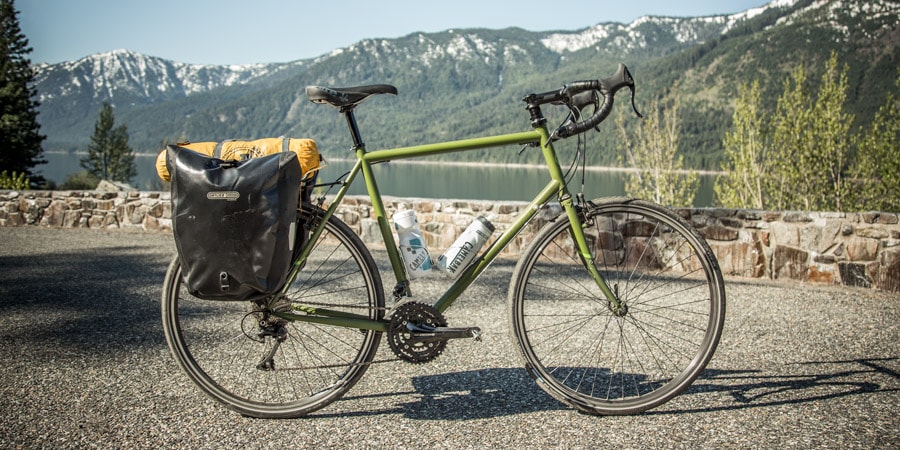
A typical touring bike looks similar to a standard road bike; a touring bike has the same basic shape and usually has dropbars. But there are subtle differences, such as the touring bike's more upright riding position and a geometry that helps maintain stability while carrying lots of weight. Many touring bikes come ready to carry front and rear racks for hauling gear in panniers. Shop Road Bikes
Gravel bikes are built to handle rougher terrain. For instance, many have bigger, knobbier tires for gravel roads and dirt trails. Some use 650b wheels and tires similar to those found on some mountain bikes for better grip and bump absorption on rough roads and trails. Many gravel bikes include mounts for attaching racks to haul gear in panniers.
If you're interested in riding exclusively on dirt roads and trails, you'll also want to read our article, How to Choose a Bike for Bikepacking.
Key Features in Touring Bikes
The geometry of a bike frame, the materials used to construct it and the components that are on it can play a big part in how the bike feels, especially when you're hauling a heavy load and riding on variable surfaces. If you're purchasing a touring-specific bike, the manufacturer incorporates these factors into the design. But if you're wondering if the road bike you have at home will work, it can be helpful to have a basic understanding of how these impact ride quality. Here's a look at some of the key differences between road bikes and touring bikes.
Frame Geometry for Touring Bikes
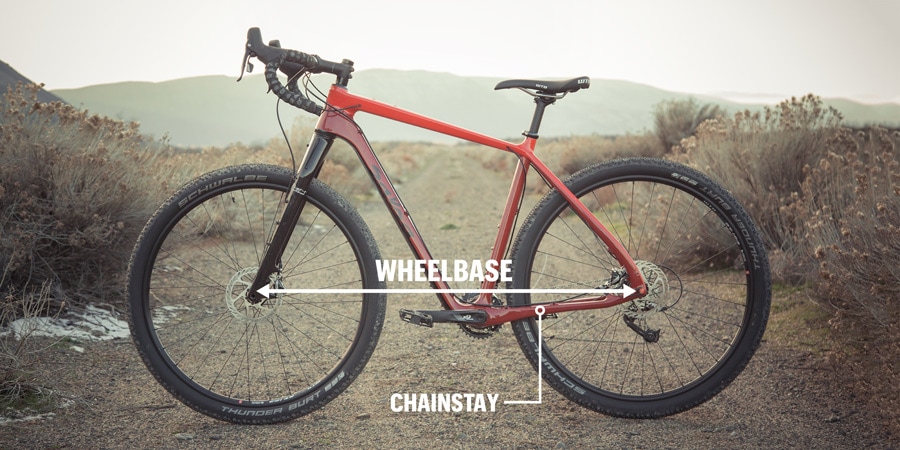
Bikes meant specifically for bike touring are designed so they can remain comfortable and stable while carrying a heavy load. To accomplish this, you'll find that most touring bikes have longer wheelbases than road bikes. (The wheelbase is the horizontal distance between the hubs of the front and rear wheels.) Longer wheelbases generally allow for easier steering and better stability while carrying a load. Something else you're likely to see on a touring bike is longer chainstays (the part of the frame that's nearest to the chain). By extending these, frame builders can create more space for rear panniers on the bike.
Frame Materials for Touring Bikes
The most common choice for bike tourers is chromoly steel for its strength and smooth ride quality—steel is able to absorb road vibrations to create a less jarring feel compared to some other materials. Bike tourers also tend to choose steel for its durability, especially for traveling long distances in remote locations. Steel is unlikely to break, but if it does, it may be possible to repair the damage with welding.
Learn more about bike frame materials.
Wheels for Touring Bikes
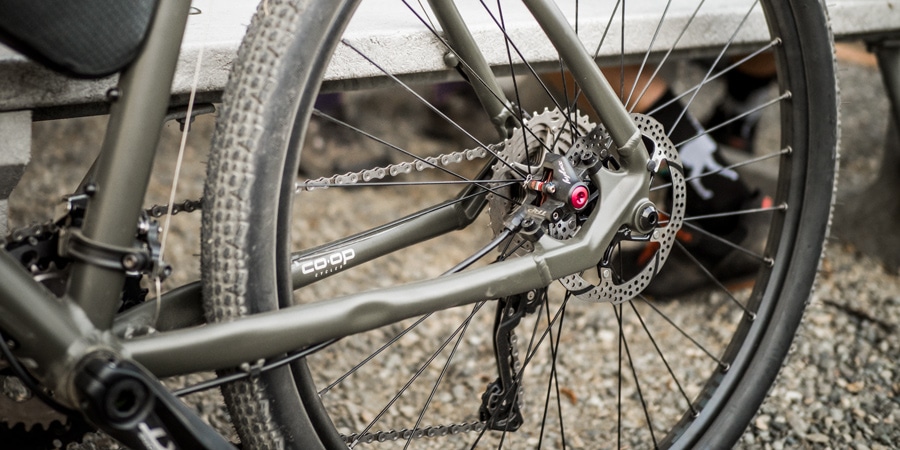
When considering wheels for touring bikes, look at:
- Number of spokes: With all that weight you're hauling on your touring bike, it's good to think about the strength of the wheels. More spokes typically mean stronger wheels, so a good general recommendation is to choose wheels that have at least 32 spokes. Wheels with 36 spokes are often a better choice if you're going to be carrying lots of weight and/or riding on rough roads. It's also worth paying attention to how many times the spokes cross each other. Some lightweight race wheels have spokes that don't cross at all. For touring, you'll want spokes that cross each other twice or even three times.
- Wheel size: When considering the right wheel size for your touring bike, think about the surfaces you'll be riding on and where in the world you plan to go. For most tourers who stick to primarily paved surfaces and won't be heading too far off into the developing world, the standard road wheel size, which is 700c, will be just fine. But if you're planning a long-distance tour that will take you onto dirt and into remote international locations, then going with smaller 650b or 26-inch wheels may be the right decision because the tires you can put on them generally provide better grip and bump absorption than those that go on 700c wheels. A plus for 26-inch wheels is that the appropriate size tires, tubes and spokes can be found just about anywhere in the world.
Learn more about wheels in our article, How to Choose Bike Wheels.
Tires for Touring Bikes
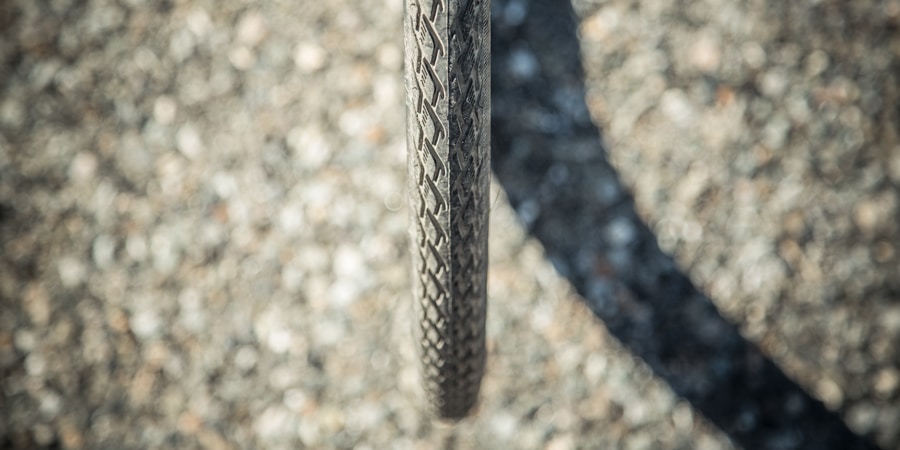
When considering tires for touring bikes, think about:
- Puncture resistance: When you're logging lots of miles on a long tour, the potential for a flat tire is very real. For this reason, many bike tourers opt for tires that have built-in puncture resistance. This will add to the weight of the tires but will significantly reduce the number of flats you get. You may also choose to use a sealant that will repair a small puncture and let you keep rolling. Learn more about puncture-resistant tires, sealants and other ways to prevent flat tires in our article, How to Prevent a Flat Bike Tire.
- Tread: A little tread offers better traction on a variety of road surfaces. Unless you're riding on dirt and gravel, you won't want tires with big knobs, but a simple traction pattern is generally preferred over slick road tires.
- Tire size: Another important consideration is the size of the tires. Many bike tourers choose tires that are at least 35mm wide, even when riding primarily on pavement. This may seem really wide if you're used to running skinny tires on your road bike, but the extra width will provide a softer, more comfortable ride. It will also add weight to your bike and may slow you down a bit, but these are compromises most bike tourers are more willing to accept. If you're considering adding larger tires to a bike you already own, you'll need to make sure there's enough clearance to do so without the tires rubbing the bike frame. Learn more about tire sizes in our article, How to Choose Bike Tires.
Gearing for Touring Bikes
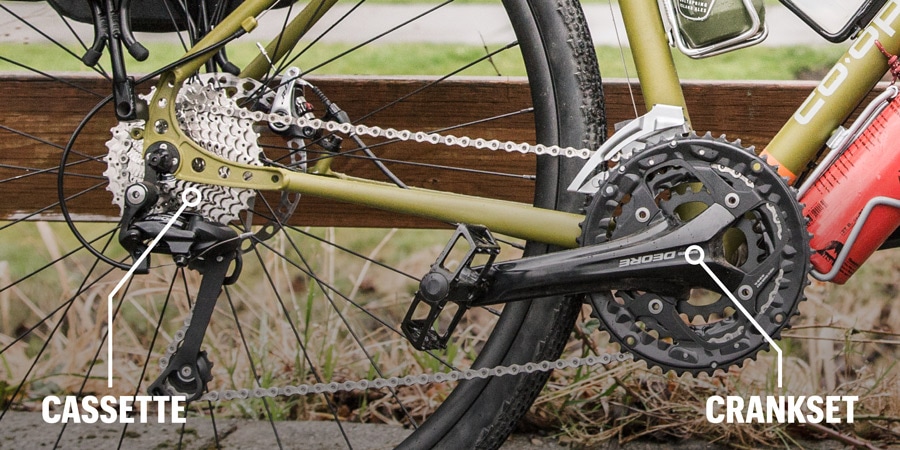
A discussion about gearing can get complex when you start counting the teeth on cogs and considering gear inches. If you want to geek out on it, go right ahead, but you can keep things simple by choosing a bike that's designed for the type of riding you want to do; one that's intended for bike touring will almost certainly be outfitted with the appropriate gearing to meet your needs. For most bike tourers, this means having a 3x crankset with a 9- or 10-speed cassette. (Read more about bike gears and shifting basics.)
Here are some things to keep in mind about bike gears for touring bikes:
- Choose more easy gears than hard gears: When you need to pedal your loaded bike up a steep mountain pass, you'll appreciate having really easy gears. So, it's a good idea to outfit your touring bike with one or two gears that are easier than anything you'd normally use when not touring. If you're familiar with the concept of gear inches, you want to look for a lowest gear of about 20 gear inches.
- Make sure you have dependable, durable components: Pedaling hundreds or thousands of miles on a tour can take its toll on parts, so it's wise to choose components that will stand up over the long haul. This often means avoiding the newest or lightest thing to hit the market and opting for a slightly heavier, more-durable option.
- Simpler gearing is often better: A drivetrain featuring high-end, specialized components may offer advantages such as smoother shifting and a wider gear range. But it can also be fussy to maintain and difficult to fix if something goes wrong during your ride. With a simpler setup, you're more likely to have the tools and skills to perform basic repairs on your own, and if you can't, you're more likely to be able to find a mechanic in town who can get you back on the road. That said, some tourers swear by complex internal geared hubs because they require almost zero maintenance and offer incredibly smooth shifting. Even though internal hubs have proven themselves to be very reliable, if something does go wrong, there's no fixing it yourself—you'll have to send the hub back to the manufacturer for service. For this reason, many bike tourers opt for a simpler, more-traditional derailleur setup. Added bonus: Simpler components are often less expensive, which is certainly the case here.
Brakes for Touring Bikes
When you're talking about strapping upwards of 30 or 40 pounds on a bike and setting out on a long-distance tour, it's wise to consider just how you'll slow down and stop when you must. The two main ways of doing so are via rim brakes and disc brakes.
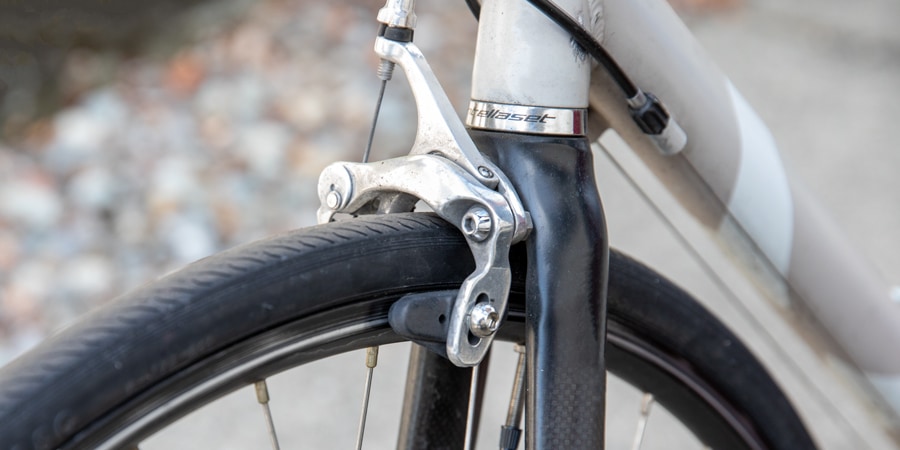
Rim brakes: Bike touring bikes have traditionally come equipped with rim brakes. Rim brakes feature pads that grip on the rims of the wheels. Here are some of the advantages and disadvantages when compared with disc brakes:
- Advantages: Relatively inexpensive; easy to observe brake pad wear; easy to replace worn pads; compatible parts can be found almost anywhere in the world.
- Disadvantages: Gradually wear out the wheel rim, requiring the wheel to eventually be replaced; less stopping power; less effective in wet or muddy conditions; require more effort to stop a loaded touring bike.
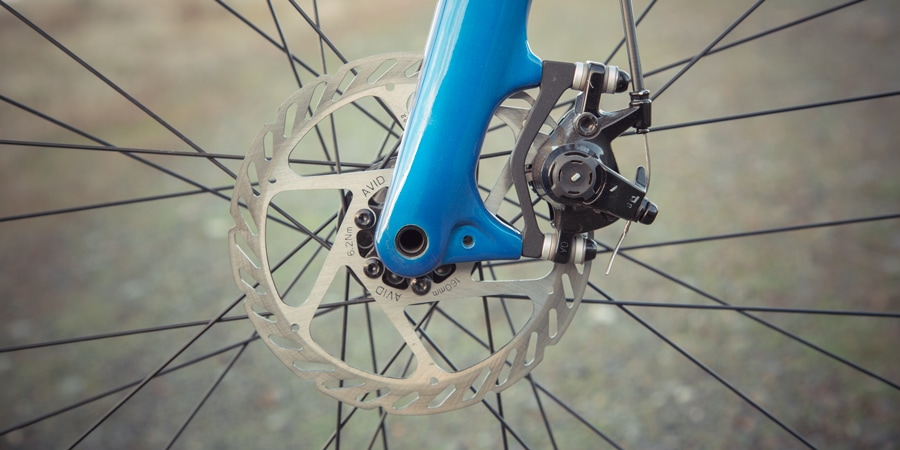
Disc brakes: Disc brakes feature brake pads that grip onto a brake rotor mounted on the wheel hub. Disc brakes come in two versions:
- Hydraulic disc brakes offer more progressive and stronger braking with less effort. They are very reliable, but should something go wrong with the hydraulics, you'll likely need to visit a bike shop to get things sorted out.
- Mechanical disc brakes require more effort to brake than hydraulics and the pads require manual adjusting as the pads wear.
Compared with rim brakes, disc brakes have several advantages and disadvantages:
- Advantages: More reliable braking in all conditions; better performance on steep terrain with a loaded bike; cheaper to replace a worn rotor than a wheel worn out by rim brakes.
- Disadvantages: More difficult to observe pad wear and replace pads; potentially more difficult to find replacement parts during a tour; harder to service in the field; hydraulic disc brakes are more expensive to service.
When deciding between rim and disc brakes, it may be helpful to think about where you're likely to ride and what your priorities are. If you're going to be riding mountainous routes in all types of weather, then disc brakes may be a better choice, as they will provide better stopping power. But if you plan to travel the globe and value ease of maintenance over increased stopping power, then rim brakes may be best for you.
Accessories and Other Features for Bike Touring
There are lots of accessories and features that can influence how well a bike will perform on a bike tour. Here are a handful of things to consider:
Pedals
Not all bikes come with pedals, so you may have to purchase them separately. When choosing pedals, you have three primary options: platform pedals, pedal toe clips and straps, and clipless pedals.
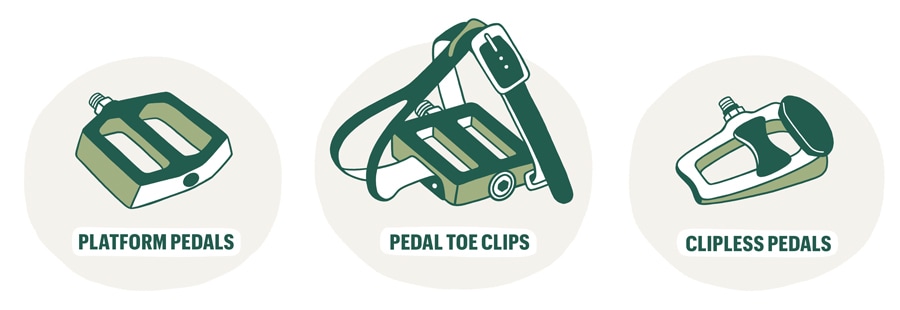
- Platform pedals are basic flat pedals. They are increasingly popular among bike tourers because they can be used with just about any type of footwear.
- Pedal toe clips and straps attach to some platform pedals and will allow you to pull up with your foot during the pedal stroke as well as push down.
- Clipless pedals require specific bike shoes that attach to the pedals when you're riding. These provide excellent pedaling efficiency and are preferred by lots of riders. But, as mentioned, they require specific bike shoes, so you'll need to consider the compatibility of pedals and shoes, and you may need to bring off-bike shoes along for when you're not riding. That said, there are casual style bike shoes and sandals that are fairly comfortable for walking. Learn more in our articles, How to Choose Bike Pedals and How to Choose Bike Shoes.
Braze-ons
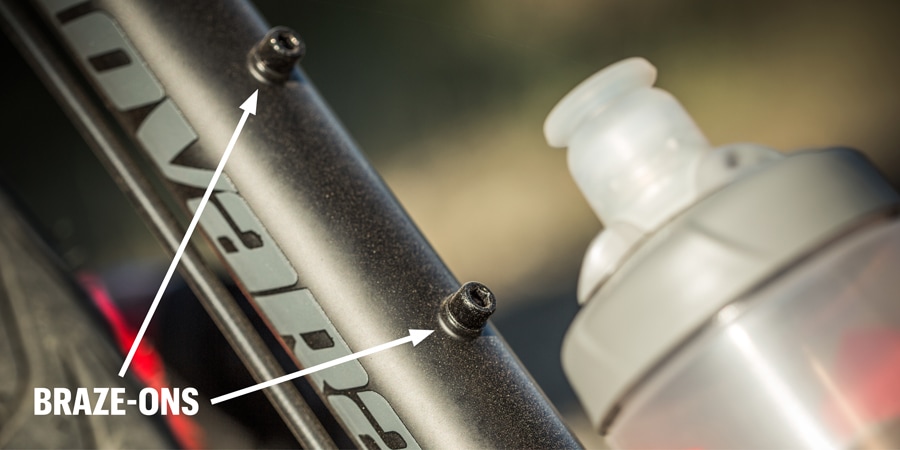
Braze-ons are threaded fittings that accept bolts; a bike designed for bike touring will have lots of them, so you can easily attach racks, water bottle cages and accessories. They are generally located on the fork, seat tube and/or down tube. If the bike you're using doesn't have braze-ons where you need them, there are accessories and workarounds so that you can still attach things, you'll just have to work a little harder to figure it out.
Racks
Front and rear racks are standard equipment for long-distance bike tourers. They allow you to attach panniers and strap on extra gear. Some bike touring bikes will come with racks, others will require you to buy racks separately and install them. Learn more in our articles, How to Choose Bike Racks and Bags and How to Pack for Bike Touring.
Handlebars
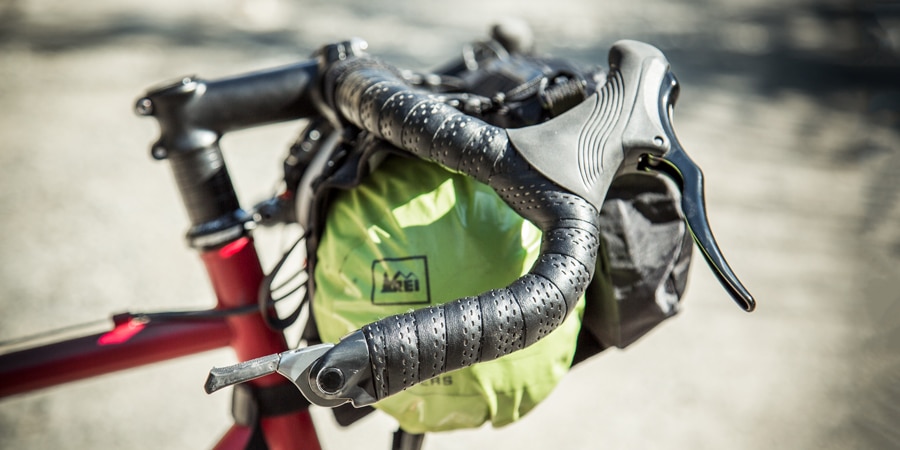
Most touring bikes come with a dropbar handlebar. A dropbar handlebar is great for the many different grip positions it provides—during a long-distance bike tour, it's nice to be able to change your body position to give certain muscles a break. But some bike tourers like a flat handlebar, more like what you'd find on a mountain bike. This generally allows a comfortable upright riding position but lacks the multiple grip positions. More recently, options have come out that are modeled after a flat handlebar but allow you to put your hands in multiple places.
Fenders
Most bike tourers consider fenders an essential accessory for blocking splattered mud and rain from soaking them while riding. They're not too difficult to add, but you will need to consider the size of your tires and whether your bike frame allows enough clearance when the fenders are in place.


